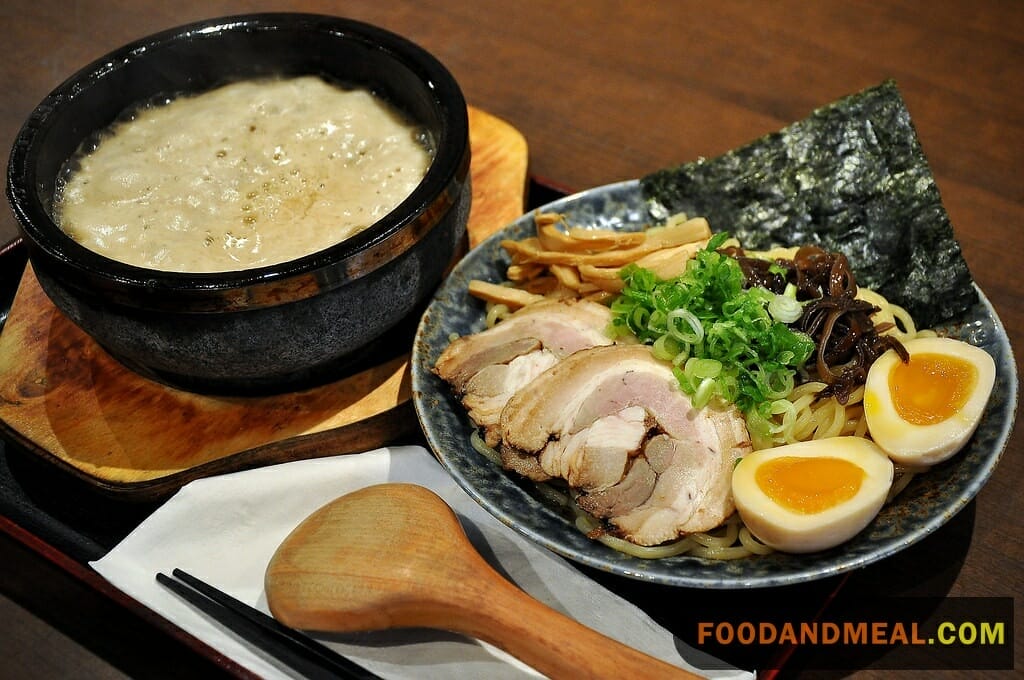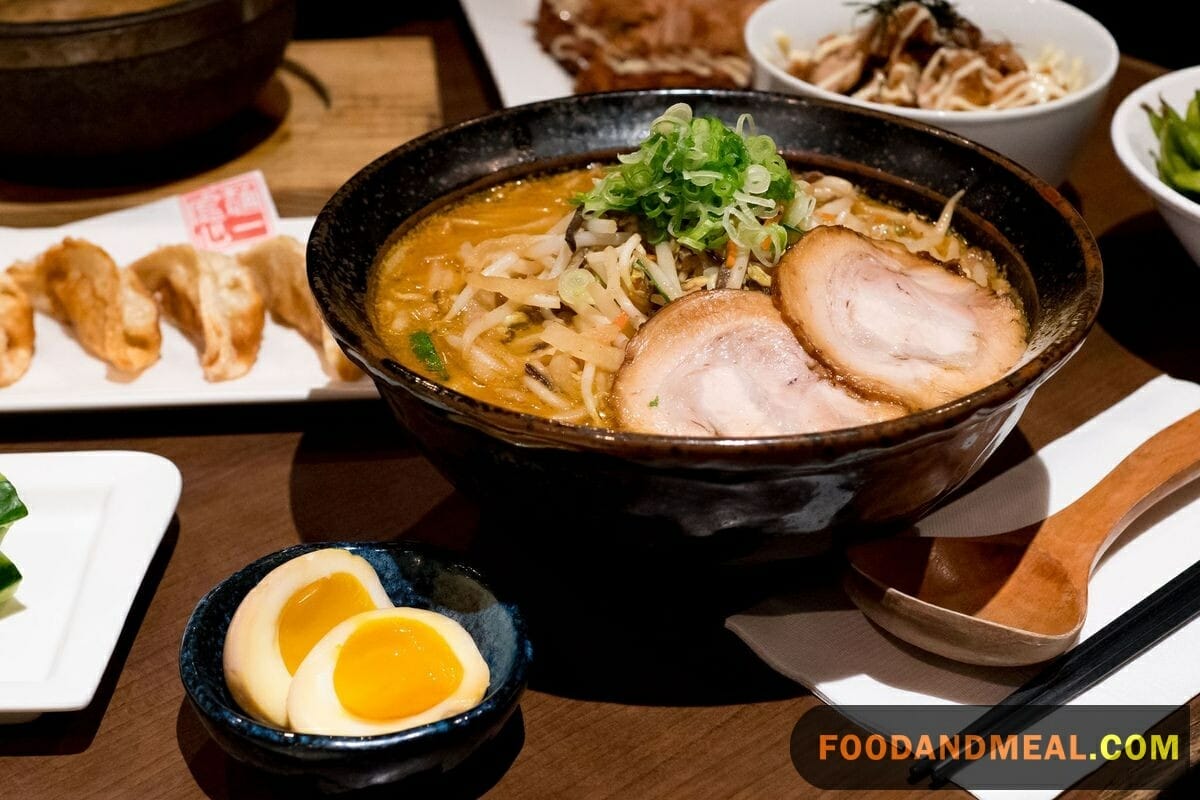Kotteri Tsukemen is a popular noodle dish in Japan. It is a noodle dish that is separated from the broth. The broth is usually made from chicken bones, but can be composed of any number of ingredients. Traditionally, it is made from pork and chicken bones. This type of ramen is brewed in stock pots and simmered slowly, which produces a clear, rich broth.

Kotteri Tsukemen Recipes

Kotteri Tsukemen
Ingredients
- 2 pounds fresh noodles such as Takasuimen
- 6 cups Thick Vegetarian Creamy Soup
- ½ cup Shoyu Tare
- ½ cup niboshi dried fish powder
- 8 to 16 slices Pork Chashu
- 4 Ajitama halved
- 16 to 20 pieces Menma
- Negi
Instructions
- Bring a large pot of water to a boil over medium-high heat. Cook the noodles. Tsukemen is better with thick noodles, and noodles that are around 4 mm thick will cook in around 8 minutes.
- Strain the noodles and run under cool water until the noodles are at room temperature.
- Put the soup, tare, and fish powder in a medium saucepan. Mix and bring to a simmer over low heat. Ladle the hot soup into small bowls.
- Serve the noodles on large plates, topped with 4 to 6 slices of chashu, 1 egg, 4 or 5 pieces of menma, and a sprinkle of negi.
Video
Notes
Nutrition
© Food And Meal
This website provides approximate nutrition information for convenience and as a courtesy only. Nutrition data is gathered primarily from the Spoonacular Database, whenever available, or otherwise other online calculators.
Slow Cooker Kotteri Tsukemen

Ingredients:
- 200g fresh ramen noodles
- 1 lb pork bones
- 1 lb chicken bones
- 2 fish carcasses
- 1 onion, quartered
- 4 cloves garlic, smashed
- 1 piece of ginger, sliced
- 1 leek, sliced
- Water to cover
- Salt to taste
- Toppings: boiled eggs, nori, green onions, bamboo shoots
Instructions:
- Prepare the Broth: Begin by placing the pork bones, chicken bones, and fish carcasses into the slow cooker. These elements are the soul of the dish, promising a broth that’s deeply flavored and rich.
- Add Aromatics: Introduce the onion, garlic, ginger, and leek to the mix. Each ingredient contributes its unique notes, weaving a complex, multi-layered flavor profile.
- Let it Simmer: Cover the ingredients with water, ensuring everything is submerged. Set the slow cooker on low and let it work its magic for 8-10 hours. The gentle, consistent heat extracts every ounce of flavor, resulting in a broth that’s both intense and harmonious.
- Strain and Season: Strain the broth to obtain a clear, rich liquid. Season with salt, tasting as you go to ensure a perfect balance that accentuates, not overwhelms, the natural flavors.
- Prepare the Noodles: As the broth nears completion, cook the ramen noodles according to the package instructions, aiming for that perfect, chewy texture that defines a delightful Tsukemen experience.
- Assemble and Serve: Place the noodles in a bowl, with the rich, aromatic broth served alongside. Adorn with toppings like boiled eggs, nori, sliced green onions, and bamboo shoots, adding both visual appeal and complex textures and flavors.
Tips for making Kotteri Tsukemen

Serving Suggestions
- Garnishes to Elevate: Adorn the dish with an array of vibrant, texturally diverse garnishes like boiled eggs, crisp nori, and tender bamboo shoots. Each addition should weave into the fabric of flavors seamlessly, illuminating the depth of the broth and the succulence of the noodles.
- Pairing with Beverages: Consider the gentle embrace of a well-aged sake or a light yet aromatic white wine to cleanse the palate, offering a refreshing contrast and making every bite as invigorating as the first. Non-alcoholic alternatives like a delicate green tea can also harmonize beautifully with the dish’s rich tones.
- Visual Appeal: Present the dish with aesthetic finesse, paying homage to the rich cultural tapestry from which this culinary gem emerges. Traditional Japanese serving ware, the thoughtful placement of garnishes, and the deliberate yet artistic separation of noodles and broth can turn the meal into a visual and sensory celebration.
Cooking Tips

- Quality of Ingredients: The soul of Kotteri Tsukemen lies in the richness of its ingredients. Opt for fresh, quality elements. The bones, the fish carcasses, the aromatic vegetables – each is a verse in this poetic creation, and quality is key.
- The Simmer: Resist the rush. The slow, gentle simmer is where the magic lies, where flavors meld, and aromas rise. It’s a silent dance, one that demands patience, letting the ingredients unveil their essence in their own time.
- Common Mistakes: Avoid the temptation to overload with seasonings. The beauty of Kotteri Tsukemen is in its inherent flavors, the natural symphony of ingredients. Let them sing, unburdened by an excess of added tastes. Balance is the silent conductor in this symphony.
FAQs of Kotteri Tsukemen

- Can I Use Instant Ramen Noodles? Absolutely, but keep in mind that the quality of noodles can significantly impact the overall taste and texture of the dish. Instant noodles can be a quick alternative, but fresh or dried ramen noodles are recommended for an authentic experience.
- How Can I Store the Leftover Broth? Cool the broth to room temperature and transfer it into an airtight container. It can be stored in the refrigerator for up to 5 days. Reheat gently on the stove, allowing the flavors to reawaken.
- Is There a Vegetarian Alternative? Yes, a rich vegetable broth infused with mushrooms for umami can replace the traditional pork, chicken, and fish-based broth. Ensure to add depth with a variety of vegetables and seasonings to mimic the complexity of the traditional version.
- Can I Add Spice to Kotteri Tsukemen? Certainly! Feel free to introduce a dash of chili oil or spicy miso paste to add a zing to the rich, savory broth, ensuring a beautiful balance that caters to those who adore a touch of heat.
- How Do I Achieve the Perfect Noodle Texture? Cook the noodles al dente. They should be tender yet retain a slight chewiness. Avoid overcooking, as the noodles will continue to cook slightly when dipped into the hot broth, achieving the perfect, succulent texture.
Discover the soul-stirring journey of making Kotteri Tsukemen. Dive into a world where flavors dance and aromas tell tales. Click, cook, and savor!
I'm James F Anderson, a noted sous chef from London and a Le Cordon Bleu alumnus. My career began in a Michelin-starred Parisian eatery, where my blend of classic and contemporary cooking, using seasonal ingredients, earned accolades. Recognized in culinary publications and on cooking shows, I’m committed to mentoring aspiring chefs and delivering memorable dining experiences, marking me as a standout talent in the culinary world.




